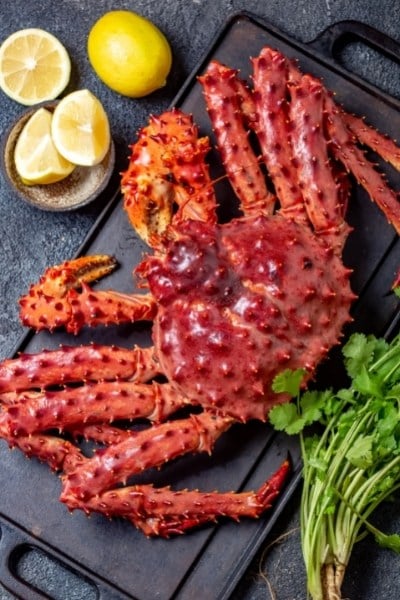Crabmeat is white, delicate, and sweet. It can be boiled, steamed, or fried. You can also use it in salads, soups, and stews.

Crab is a good source of protein, selenium, and vitamin B12. But is crabmeat high in iodine?
Table of Contents
- Is crab high in iodine?
- How much iodine is in crab?
- What’s the type of crab to eat?
- What crab is high in iodine?
- Can you take in too much iodine from crab?
- What similar food to crab has iodine?
- Is it OK to eat crab every day?
- Why is iodine essential?
- How much iodine per day?
- What is the side effect of eating crab?
- Conclusion
Is crab high in iodine?
Crab is a source of iodine but contains less iodine than other seafood. Some people who don't eat other seafood may still want to include crab in their diet because it's a good source of protein, omega-3 fatty acids, and vitamin B12. Crab is also low in mercury and other contaminants.
How much iodine is in crab?
The concentration of iodine in crab is about 26–50 mcg in a 100 g serving. The iodine content of crab can vary depending on the season and the water quality where it’s caught.
It’s therefore beneficial to include crab in your diet, especially if you don't eat other seafood.

What’s the type of crab to eat?
The most common types of eatable crab include:
1. Blue crabs
These crabs can be found in the Gulf of Mexico and the Atlantic coast. They’ve got a sweet, delicate flavor and are great for salads, soups, or as a main course.
2. Dungeness crabs
Found in the Pacific Northwest and have a rich, sweet flavor. They're perfect for grilling, steaming, or boiling.
3. King crab
King crabs come from the Bering Sea and have a sweet, succulent taste. They're perfect for steaming, frying, or boiling.

4. Snow crab
These crabs come from the Atlantic and Pacific Oceans. They have a delicate flavor and are perfect for steaming, boiling, or frying.
5. Soft-shell crab
Found in the Atlantic and Gulf of Mexico, they're perfect for grilling or frying.
6. Tanner crabs
These crabs come from the Bering Sea and have a rich, slightly sweet flavor. They're perfect for boiling or frying.
7. Yellow crab
Yellow crabs live in the Indo-Pacific. They have a delicate, sweet flavor and are perfect for steaming, boiling, or frying.
What crab is high in iodine?
The type of crab that’s high in iodine is the blue crab. It contains 50 mcg of iodine in a 100-g serving. If you don't eat other seafood, including blue crab in your diet is beneficial.

Can you take in too much iodine from crab?
Eating iodine from crab is unlikely to cause an iodine overdose. The concentration of iodine is relatively low, and it's unlikely that you would consume too much iodine from the crab.
However, if you’re taking supplements that contain iodine, it’s essential to be careful not to consume too much iodine. Excessive iodine intake can cause health problems such as thyroid dysfunction.
What similar food to crab has iodine?
The substitute for crab that has iodine are:
1. Cod: A 100-g serving of cod contains about 117 mcg of iodine.
2. Haddock: A 85-g serving of haddock contains about 87 mcg of iodine.
3. Halibut: A 100-g serving of halibut contains about 21 mcg of iodine.
4. Salmon: A 100-g serving contains about 31 mcg of iodine.
5. Shrimp: A 100-g serving contains about 41 mcg of iodine.
Is it OK to eat crab every day?
Yes, it is OK to eat crab every day. It's recommended because it is a good source of protein, omega-3 fatty acids, and vitamin B12.
It’s also low in mercury and other contaminants. But it's important to include another type of food in your diet to get the right nutrients.
It's also important to be careful not to consume too much iodine if you're taking iodine supplements.
Why is iodine essential?
Iodine is a mineral that’s essential for human health. It’s mainly concentrated in the thyroid gland and helps to regulate the body's metabolism.
Iodine is also necessary for the production of thyroid hormones. An iodine deficiency can cause thyroid problems such as goiter.
Iodine is also important for pregnant women and children. Pregnant women need iodine to ensure a healthy pregnancy, and children need iodine to help with growth and development. Iodine is also important for cognitive development.

How much iodine per day?
A recommended daily intake of iodine is 140-150 mcg per day. This can be met by consuming various iodine-rich foods such as seafood, dairy products, and eggs.
If you’re not getting enough iodine from your diet, you may need a supplement. Check with your doctor to see if you need to take an iodine supplement.
What is the side effect of eating crab?
1. Iodine poisoning
Consuming too much iodine can cause health problems such as thyroid dysfunction.
2. Allergic reaction
Some people may experience an allergic reaction to crab. Symptoms may include itching, swelling, and respiratory problems.
3. Food poisoning
Crabs can be contaminated with bacteria such as E. coli. This can cause food poisoning symptoms such as diarrhea, vomiting, and fever.
4. Mercury poisoning
Crabs can also contain high levels of mercury. This can cause mercury poisoning symptoms such as dizziness, confusion, and muscle weakness.
5. Shellfish allergy
Crab is a type of shellfish, and some people may have an allergic reaction to it. Symptoms may include wheezing, swelling of the lips, and hives.
Conclusion
In conclusion, crab is an important food that’s high in iodine and other nutrients. It's also low in contaminants, making it a safe choice for seafood lovers.
Crabs are a healthy choice for everyone, including pregnant women and children therefore, it's a good choice for a healthy diet.
